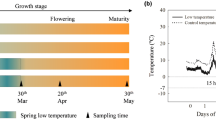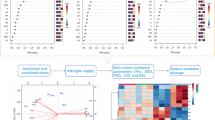Abstract
Herbicides are largely used to control weed growth in wheat production. However, the application of some kind of herbicides usually aggravates the damage caused by low temperature, and is also a very common adversity during the early growth stages of wheat. In this study, we pre-treated wheat seedlings with the herbicide chemicals of isoproturon, fluroxypyr and fenoxaprop-P-ethyl, respectively and then exposed the plants to low temperature stress with different time intervals. The herbicides, especially isoproturon, significantly increased the negative effects of low temperature on electron transport rate, chlorophyll content, cell membrane stability as well as growth of wheat plants. Furthermore, the foliar application of ascorbic acid (AsA) decreased relative electric conductivity, reduced the content of malondialdehyde, and reduced the production rate of reactive oxygen species, these were in line with elevated activities of superoxide dismutase, catalase and peroxidase under the combined stress of isoproturon and low temperature, indicating that AsA effectively mitigated the sever oxidative stress induced by the combined stresses. Thus, some of the herbicides such as isoproturon are suggested to be very carefully used before the possibility of low temperature events. In case low temperature stress occurs after using of isoproturon, AsA could be used to partially alleviate the damage by the combined stress of isoproturon and low temperature in wheat production.





Similar content being viewed by others
References
Alexieva V, Sergiev I, Mapelli S, Karanov E (2001) The effect of drought and ultraviolet radiation on growth and stress markers in pea and wheat. Plant Cell Environ 24:1337–1344
Alla MMN, Hassan NM (2014) Alleviation of isoproturon toxicity to wheat by exogenous application of glutathione. Pestic Biochem Physiol 112:56–62
Aravind P, Prasad MN (2005) Modulation of cadmium-induced oxidative stress in Ceratophyllum demersum by zinc involves ascorbate-glutathione cycle and glutathione metabolism. Plant Physiol Biochem 43:107–116
Arnaud L, Taillandier G, Kaouadji M, Ravanel P, Tissut M (1994) Photosynthesis inhibition by phenylureas: a QSAR approch. Ecotoxicol Environ Saf 28:121–133
Ashraf M, Harris PJC (2013) Photosynthesis under stressful environments: an overview. Photosynthetica 51:163–190
Athar H-u-R, Khan A, Ashraf M (2008) Exogenously applied ascorbic acid alleviates salt-induced oxidative stress in wheat. Environ Exp Bot 63:224–231
Baek K-H, Skinner DZ (2003) Alteration of antioxidant enzyme gene expression during cold acclimation of near-isogenic wheat lines. Plant Sci 165:1221–1227
Buer Jv, Cvetkovic J, Baier M (2016) Cold regulation of plastid ascorbate peroxidases serves as a priming hub controlling ROS signaling in Arabidopsis thaliana. BMC Plant Biol 16:163
Cakmak I, Horst W (1991) Effect of aluminium on lipid peroxidation, superoxide dismutase, catalase, and peroxidase activities in root tips of soybean (Glycine max). Physiol Plant 83:463–468
Conklin P (2001) Recent advances in the role and biosynthesis of ascorbic acid in plants. Plant Cell Environ 24(4):383–394
Deshmukh P, Sairam R, Shukla D (1991) Measurement of ion leakage as a screening technique for drought resistance in wheat genotypes. Indian J Plant Physiol 34:89–91
Erdal S, Genisel M, Turk H, Dumlupinar R, Demir Y (2015) Modulation of alternative oxidase to enhance tolerance against cold stress of chickpea by chemical treatments. J Plant Physiol 175:95–101
Farooq M, Aziz T, Wahid A, Lee D, Siddique K (2009) Chilling tolerance in maize: agronomic and physiological approaches. Crop Pasture Sci 60:501–516
Fracheboud Y, Haldimann P, Leipner J, Stamp P (1999) Chlorophyll fluorescence as a selection tool for cold tolerance of photosynthesis in maize (Zea mays L.). J Exp Bot 50:1533–1540
Genty B, Briantais J, Baker N (1989) The relationship between the quantum yield of photosynthetic electron transport and quenching of chlorophyll fluorescence. Biochim Biophys Acta 990:87–92
Hjorth M, Mondolot L, Buatois B, Andary C, Rapior S, Kudsk P, Mathiassen SK, Ravn HW (2006) An easy and rapid method using microscopy to determine herbicide effects in Poaceae weed species. Pest Manag Sci 62:515–521
Iba K (2002) Acclimative response to temperature stress in higher plants: approaches of gene engineering for temperature tolerance. Ann Rev Plant Biol 53:225–245
Kim TE, Kim S-K, Han TJ, Lee JS, Chang SC (2002) ABA and polyamines act independently in primary leaves of cold-stressed tomato (Lycopersicon esculentum). Physiol Plant 115:370–376
Kooten O, Snel JF (1990) The use of chlorophyll fluorescence nomenclature in plant stress physiology. Photosynth Res 25:147–150
Kramer D, Johnson G, Kiirats O, Edwards G (2004) New fluorescence parameters for the determination of QA redox state and excitation energy fluxes. Photosynth Res 79:209–218
Kumar S, Kaur R, Kaur N, Bhandhari K, Kaushal N, Gupta K, Bains TS, Nayyar H (2011) Heat-stress induced inhibition in growth and chlorosis in mungbean (Phaseolus aureus Roxb.) is partly mitigated by ascorbic acid application and is related to reduction in oxidative stress. Acta Physiol Plant 33:2091–2101
Li X, Cai J, Liu F, Dai T, Cao W, Jiang D (2014) Cold priming drives the sub-cellular antioxidant systems to protect photosynthetic electron transport against subsequent low temperature stress in winter wheat. Plant Physiol Biochem 82:34–43
Li K, Du Y, Miao Y (2016) Future challenges in understanding ROS in plant responses to abiotic stress. Sci China Life Sci 59:1343–1344
Liangdong S, Wentao F, Zhijian C (2017) Effect of herbicides on growth and production of wheat. Acta Agric Boreali-Occidentalis Sinica 26(8):1253–1258
Loewus FA (1999) Biosynthesis and metabolism of ascorbic acid in plants and of analogs of ascorbic acid in fungi. Phytochemistry 52:193–210
Lukatkin AS, Anjum NA (2014) Control of cucumber (Cucumis sativus L.) tolerance to chilling stress-evaluating the role of ascorbic acid and glutathione. Front Environ Sci 2:62
Mahajan S, Tuteja N (2005) Cold, salinity and drought stresses: an overview. Arch Biochem Biophys 444:139–158
Nemat Alla MM, Hassan NM (2007) Changes of antioxidants and GSH-associated enzymes in isoproturon-treated maize. Acta Physiol Plant 29(3):247–258
Nishiyama Y, Yamamoto H, Allakhverdiev SI, Inaba M, Yokota A, Murata N (2001) Oxidative stress inhibits the repair of photodamage to the photosynthetic machinery. EMBO J 20:5587–5594
Sayed OH (2003) Chlorophyll fluorescence as a tool in cereal crop research. Photosynthetica 41:321–330
Sui N, Li M, Liu X-Y, Wang N, Fang W, Meng Q-W (2007) Response of xanthophyll cycle and chloroplastic antioxidant enzymes to chilling stress in tomato over-expressing glycerol-3-phosphate acyltransferase gene. Photosynthetica 45:447–454
Suzuki N, Mittler R (2006) Reactive oxygen species and temperature stresses: a delicate balance between signaling and destruction. Physiol Plant 126:45–51
Tan W, Liu J, Dai T, Jing Q, Cao W, Jiang D (2008) Alterations in photosynthesis and antioxidant enzyme activity in winter wheat subjected to post-anthesis waterlogging. Photosynthetica 46:21–27
Thakur P, Kumar S, Malik JA, Berger JD, Nayyar H (2010) Cold stress effects on reproductive development in grain crops: an overview. Environ Exp Bot 67:429–443
Wang X, Cai J, Jiang D, Liu F, Dai T, Cao W (2011) Pre-anthesis high-temperature acclimation alleviates damage to the flag leaf caused by post-anthesis heat stress in wheat. J Plant Physiol 168:585–593
Wu GL, Cui J, Tao L, Yang H (2010) Fluroxypyr triggers oxidative damage by producing superoxide and hydrogen peroxide in rice (Oryza sativa). Ecotoxicology 19(1):124–132
Xie HS, Quick WA, Hsiao AI (1994) Spring cereal response to imazamethabenz and fenoxaprop-p-ethyl as influenced by environment. Weed Technol 8:713–716
Yang S-H, Wang L-J, Li S-H (2007) Ultraviolet-B irradiation-induced freezing tolerance in relation to antioxidant system in winter wheat (Triticum aestivum L.) leaves. Environ Exp Bot 60:300–307
Yin XL, Jiang L, Song NH, Yang H (2008) Toxic Reactivity of wheat (Triticum aestivum) plants to herbicide isoproturon. J Agric Food Chem 56:4825–4831
Zhang C, Liu J, Zhang Y, Cai X, Gong P, Zhang J, Wang T, Li H, Ye Z (2011) Overexpression of SlGMEs leads to ascorbate accumulation with enhanced oxidative stress, cold, and salt tolerance in tomato. Plant Cell Rep 30:389–398
Zhang JH, Guo SJ, Guo PY, Wang X (2015) The interacting effect of urea and fenoxaprop-P-ethyl on photosynthesis and chlorophyll fluorescence in Perilla frutescens. Photosynthetica 52:456–463
Acknowledgements
This study was supported by the National Key Research and Development Program of China (2016YFD0300107), the National Natural Science Foundation of China (31325020, 31401326, 31471445), the China Agriculture Research System (CARS-03), Jiangsu Collaborative Innovation Center for Modern Crop Production (JCIC-MCP), Collaborative Innovation Center of Gene Resources, the Fundamental Research Funds for the Central Universities (KJQN201505). We thank the reviewers for their constructive comments.
Author information
Authors and Affiliations
Corresponding author
Ethics declarations
Conflict of interest
The authors declare that they have no conflict of interest.
Rights and permissions
About this article
Cite this article
Wang, X., Wu, L., Xie, J. et al. Herbicide isoproturon aggravates the damage of low temperature stress and exogenous ascorbic acid alleviates the combined stress in wheat seedlings. Plant Growth Regul 84, 293–301 (2018). https://doi.org/10.1007/s10725-017-0340-x
Received:
Accepted:
Published:
Issue Date:
DOI: https://doi.org/10.1007/s10725-017-0340-x




